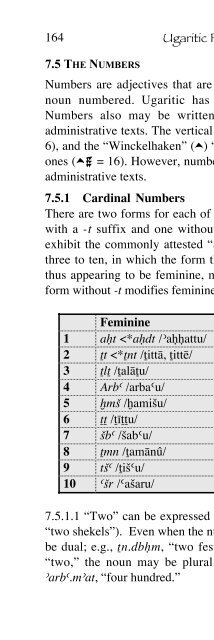- Page 2:
This page intentionally left blank
- Page 8:
A Primer on Ugarit
- Page 12:
for Jeanne for Alice
- Page 18:
viii Contents 3.8 From Tlmym to T r
- Page 22:
x Contents 7.7.5 Conjunctions 170 8
- Page 28:
Abbreviations ABD Anchor Bible Dict
- Page 32:
Acknowledgments Many people have co
- Page 38:
2 Ugaritic Primer
- Page 42:
4 Ugaritic Primer
- Page 46:
6 Ugaritic Primer
- Page 50:
8 Ugaritic Primer
- Page 54:
10 Ugaritic Primer
- Page 58:
12 Ugaritic Primer
- Page 62:
14 Ugaritic Primer
- Page 66:
16 Ugaritic Primer
- Page 70:
18 Ugaritic Primer
- Page 74:
20 Ugaritic Primer
- Page 78:
22 Ugaritic Primer
- Page 82:
24 Ugaritic Primer
- Page 86:
26 Ugaritic Primer
- Page 90:
28 Ugaritic Primer
- Page 94:
30 Ugaritic Primer
- Page 98:
32 Ugaritic Primer
- Page 102:
34 Ugaritic Primer
- Page 106:
36 Ugaritic Primer
- Page 110:
38 Ugaritic Primer
- Page 114:
3 Letters An Inductive Introduction
- Page 118:
42 Ugaritic Primer
- Page 122:
44 Ugaritic Primer
- Page 126:
46 Ugaritic Primer
- Page 130:
48 Ugaritic Primer
- Page 134:
50 Ugaritic Primer
- Page 138:
52 Ugaritic Primer
- Page 142:
54 Ugaritic Primer
- Page 146:
56 Ugaritic Primer
- Page 150:
58 Ugaritic Primer
- Page 154:
60 Ugaritic Primer
- Page 158:
62 Ugaritic Primer
- Page 162:
64 Ugaritic Primer
- Page 166:
66 Ugaritic Primer
- Page 170:
68 Ugaritic Primer
- Page 174:
70 Ugaritic Primer
- Page 178:
72 Ugaritic Primer
- Page 182:
74 Ugaritic Primer
- Page 186:
76 Ugaritic Primer
- Page 190:
78 Ugaritic Primer
- Page 194:
80 Ugaritic Primer
- Page 198:
82 Ugaritic Primer
- Page 202:
84 Ugaritic Primer
- Page 206:
86 Ugaritic Primer
- Page 210:
88 Ugaritic Primer
- Page 214:
90 Ugaritic Primer
- Page 218:
4 Administrative Texts Most of the
- Page 222:
94 Ugaritic Primer
- Page 226:
96 Ugaritic Primer
- Page 230:
98 Legal Texts 5.1 DOCUMENT OF GUAR
- Page 234:
100 Legal Texts obligations in case
- Page 238:
102 Legal Texts 9. /tukannuœna/ th
- Page 242:
104 Legal Texts 5.2.2 Transcription
- Page 246:
106 Legal Texts Note that the synta
- Page 250:
108 Legal Texts 16. /[wa}unut]tu }e
- Page 254:
110 Legal Texts Figure 5.3 KTU 3.9
- Page 258:
112 Legal Texts do not translate th
- Page 262:
114 Legal Texts The final -w has ge
- Page 266:
116 Legal Texts problems. On the on
- Page 270:
118 Ugaritic Primer</strong
- Page 274:
120 Ugaritic Primer</strong
- Page 278:
122 Ugaritic Primer</strong
- Page 282:
124 Ugaritic Primer</strong
- Page 286:
126 Ugaritic Primer</strong
- Page 290:
128 1.14:ii, 20 {l lzr.[mg]dl 1.14:
- Page 294:
130 Ugaritic Primer</strong
- Page 298:
132 Ugaritic Primer</strong
- Page 302:
134 Ugaritic Primer</strong
- Page 306:
136 Ugaritic Primer</strong
- Page 310: 138 Ugaritic Primer</strong
- Page 314: 140 Ugaritic Primer</strong
- Page 318: 142 Ugaritic Primer</strong
- Page 322: 144 Ugaritic Primer</strong
- Page 326: 146 Ugaritic Primer</strong
- Page 330: 148 Ugaritic Primer</strong
- Page 334: 150 Ugaritic Primer</strong
- Page 338: 152 Ugaritic Primer</strong
- Page 342: 154 Ugaritic Primer</strong
- Page 346: 156 Ugaritic Primer</strong
- Page 350: 158 ay /}ayyu/, “which, any” 7.
- Page 354: 160 Ugaritic Primer</strong
- Page 358: 162 Ugaritic Primer</strong
- Page 364: Grammatical Précis 165 7.5.1.2 Num
- Page 368: Grammatical Précis 167 middle cons
- Page 372: Grammatical Précis 169 7.6.7 Suffi
- Page 376: Grammatical Précis 171 Hiphil impe
- Page 380: Grammatical Précis 173 above). 16
- Page 384: Grammatical Précis 175 Gp qutila q
- Page 388: Grammatical Précis 177 qlt /qa®la
- Page 392: Grammatical Précis 179 7.7.3 Vocat
- Page 396: Glossary 181 Arabic undoubtedly rec
- Page 400: ga-ri-ta/) }ad/}adn father; lord (c
- Page 404: Glossary 185 hÎnDmVlAa) }aln oak (
- Page 408: Glossary 187 ; ; }atrt Athirat (cp.
- Page 412:
Glossary 189 ; dblt fig cake (cp. H
- Page 416:
h hby [DN?] demon (?) (see Isa. 26:
- Page 420:
Glossary 193 T¸BH¸ to slaughter (
- Page 424:
Glossary 195 “perfection”; Akk.
- Page 428:
Glossary 197 m}ad plenty, much (cp.
- Page 432:
mtntm loins (cp. Akk. matnu “cord
- Page 436:
skn stela, monument (cp. Akk. sûˆ
- Page 440:
Glossary 203 face (cp. Akk. paœtu;
- Page 444:
qr voice, noise (cp. Mish. Heb. rqr
- Page 448:
SÁLW to repose (cp. Heb. wElDv) S
- Page 452:
T˛KM to carry on the shoulder tkm
- Page 456:
Resources for Further Study 211 Zuc
- Page 460:
Resources for Further Study 213 Vir
- Page 464:
Resources for Further Study 215 lan
- Page 468:
Resources for Further Study 217 Mor
- Page 472:
Resources for Further Study 219 Siv
- Page 476:
Resources for Further Study 221 9.1
- Page 480:
tlt 140, 143, 12 Carchemish 14 Cypr
- Page 484:
{my 58, 60, 65, 66, 67, 86 {rpt 139


